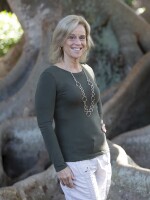The nonprofit SBAC will launch “Diversity, Equity & Inclusion in the Visual Arts,” as part of its free series on Mon., Jan. 25, beginning at 5 p.m. The moderator for the discussion is Charlayne Hunter-Gault, a leading civil rights activist, journalist and former foreign correspondent for NPR, CNN and PBS. Panel members include artist Gale Fulton-Ross; Steven High, executive director of The Ringling; Katherine Pill, curator of contemporary art at the Museum of Fine Arts in St. Petersburg; and Anne-Marie Russell, executive director of Sarasota Art Museum.
WUSF's Cathy Carter spoke with Michele Des Verney Redwine, the president of the Suncoast Black Arts Collaborative.
Michele, you've said you want leaders from area museums to be willing to participate in "courageous conversations." Can you tell us more about that?
Well, I think it does require a set of questions. And the questions help to bring forth an understanding of what you are doing, and you're not doing. Certainly, we're a small community, our executive directors and curators know each other. But we are hoping that out of this, that the leaders are going to realize that they haven't done enough to be inclusive. To be inclusive means you really have to have sensitivity, and race and culture is very sensitive in our country, but the world's changing, and this community is changing. The fastest growing communities are people of color. So how do you get people to participate? And that is very significant if any of these organizations are going to make steps toward being more inclusive.
So we have these conversations about how cultural organizations institutions can be more inclusive, how then can that be translated to action?
Okay, if we could just take those steps that will help us to understand the kinds of programs and exhibitions that we should be considering, so that our organizations are for all people. One of the most difficult things that all of these organizations have had, and they all have asked is, how can we bring people to our events to our exhibitions? And you know, you can't just send an invitation. Why would they want to come to something they don't know anything about? Find people who might be interested in being a part of these organizations. They don't have to be just the rich and the wealthy. And by the way, it's everyone's responsibility. It is not just the organizations, it's the responsibility of the communities, but they have to feel that they are wanted, that there's a place for them. So the sharing of conversations amongst leaders is important so that they can learn from each other and understand how they can impact their organizations for change, and we have to change.
And if we're looking for transformative solutions, I'm sure you have some thoughts about arts education, and how to make sure students have access to the arts, both as viewers and creators.
The most important thing is education. Last year, we sponsored with Art Center Sarasota, to offer classes in art, history and culture for African Americans. And from that exhibition, our artists went into the schools. And the most critical issue that we need to address is that students of color are not participating in the arts at the same level, and involvement as our majority students. And education takes a lot. It's not just exhibitions, but it's in the schools. It's mentoring. It's working with the teachers, and this is going to be one of the pieces that will change our community.







